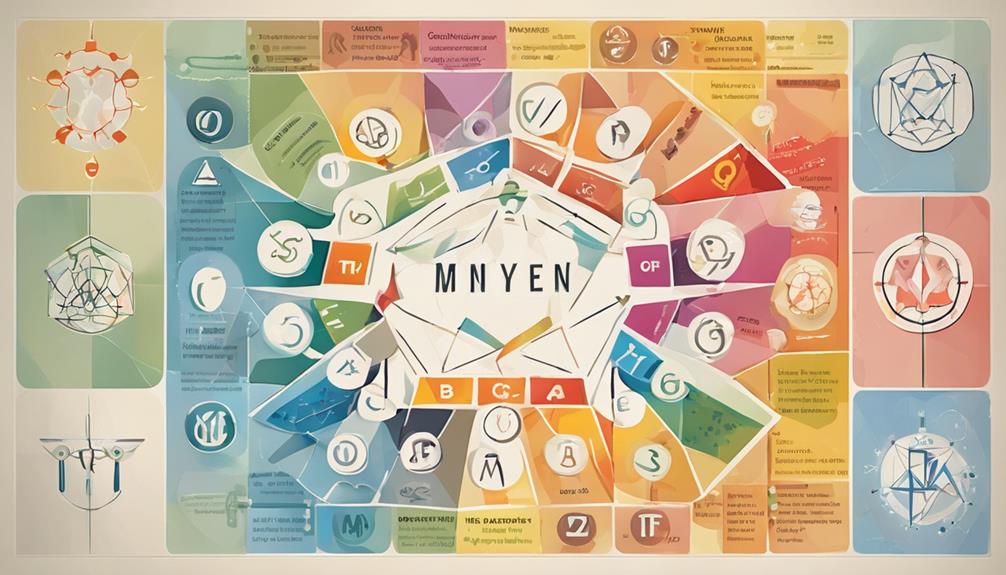Were you aware that there may be discrepancies between how we view ourselves and how others perceive us? Indeed, our actions, feelings, thinking patterns, and reasons all play a role in shaping how we are viewed by others. Recognizing how we are perceived can offer valuable insights into our social image and how we interact with others.
That’s where the “How Do Others See Me?” quiz comes in. This popular personality assessment test helps individuals gain a better understanding of how they are perceived by others. By answering a series of questions about various aspects of their personality, individuals can uncover insights into their social image, level of popularity, and areas for personal growth.
Are you curious to find out how others see you? Let’s dive in and discover what the “How Do Others See Me?” quiz has to offer!
Key Takeaways:
- The “How Do Others See Me?” quiz helps individuals understand how they are perceived by others.
- Our perception of ourselves may differ from how others see us.
- The quiz covers various aspects of personality, such as sense of humor, friendliness, creativity, and more.
- It provides insights into one’s social image and level of popularity.
- Self-awareness is crucial for personal growth and improving relationships with others.
Understanding Perception and Personality
Our perception of ourselves may not always align with how others see us. It is influenced by a combination of factors such as our behaviors, emotions, thought patterns, and motivations. Research suggests that both our genetics and our environment play a role in shaping our personalities. The “How Do Others See Me?” quiz aims to provide individuals with a better understanding of their personality and how others perceive them.
The Influence of Perception
Perception is the lens through which we view and interpret ourselves, others, and the world around us. It shapes our thoughts, beliefs, and actions, and influences how we interact with others. Our perception is often influenced by our upbringing, cultural background, life experiences, and social influences. It can be a powerful force that shapes our self-image and impacts our relationships.

The Role of Personality
Personality refers to the unique set of characteristics, traits, and behaviors that define an individual. It encompasses various aspects such as introversion or extroversion, openness to new experiences, conscientiousness, emotional stability, and agreeableness. Our personality traits influence how we perceive ourselves and how others perceive us. They also play a significant role in shaping our behavior and interactions with others.
The “How Do Others See Me?” Quiz
The “How Do Others See Me?” quiz is designed to provide individuals with valuable insights into their perception and personality. By answering a series of thought-provoking questions, participants can gain a better understanding of how they are perceived by others. The quiz covers various aspects of personality and social interactions, allowing individuals to reflect on their strengths and areas for improvement.
The “How Do Others See Me?” quiz offers a unique opportunity for individuals to gain valuable feedback and self-reflection. It provides insights into how others perceive us, helping us navigate our relationships and interactions more effectively. Taking the quiz can be a fun and enlightening experience that promotes self-awareness and personal growth.
Whether you’re curious about how your friends, family, or colleagues perceive you or simply want to gain a deeper understanding of your own personality, the “How Do Others See Me?” quiz offers an engaging and insightful experience. Take the quiz today and discover new insights about yourself!
Understanding Perception and Personality: A Comparative Analysis
| Perception | Personality |
|---|---|
| How we view ourselves and others | Unique set of characteristics and traits |
| Shaped by behaviors, emotions, and motivations | Influences behavior and interactions |
| May not align with how others see us | Defines individual identity |
| Influenced by genetics and environment | Shaped by genetics and life experiences |
Taking the Quiz
The “How Do Others See Me?” quiz offers a unique opportunity to gain insights into your social perception and discover how others perceive you. By answering a series of multiple-choice questions, you’ll delve into various aspects of your personality, including your sense of humor, friendliness, creativity, shyness, anger, and work ethic. These questions have been designed to explore different dimensions of your character and provide you with a holistic evaluation of how you are perceived.
Answer each question honestly, as this will ensure accurate and meaningful results. Remember, this quiz is not a diagnostic tool but rather an entertaining and enlightening exercise. It serves as a valuable resource to enhance your understanding of how personality traits shape the way others perceive you in social settings.
Sample Question:
Q1: How would you describe your sense of humor?
- Witty and sarcastic
- Lighthearted and playful
- Dry and sarcastic
- Observational and clever
Sample Results:
| Traits | Perception |
|---|---|
| Sense of humor | Lighthearted and playful |
| Friendliness | Approachable and warm |
| Creativity | Imaginative and innovative |
| Shyness | Reserved and introverted |
| Anger | Calm and composed |
| Work ethic | Hardworking and dedicated |

Completing the “How Do Others See Me?” quiz will give you a comprehensive snapshot of your social image and how others perceive your personality. However, please remember that these results are not scientifically validated and should be taken with a grain of salt. The quiz is designed, first and foremost, to provide a fun and thought-provoking experience that encourages self-reflection and introspection.
Understanding the Results
After completing the “How Do Others See Me?” quiz, you will receive a personalized description of your personality type based on your responses. This description provides valuable insights into how others may perceive you in terms of your sense of humor, friendliness, creativity, shyness, and other traits.
It’s important to remember that the results of the quiz are not scientifically validated and should be taken with a grain of salt. The quiz is designed to be a fun and thought-provoking way to explore your social image and gain self-awareness.
Here’s an example of what your personality type description might look like:
Your Personality Type: The Creative Enthusiast
You are known for your vibrant imagination and innovative ideas. Your sense of humor brings joy to others, and your friendly nature makes you approachable. However, your shyness may sometimes prevent you from fully expressing yourself in social settings. Embracing your creativity can lead to new opportunities and deep connections with others.
By reflecting on your personality type and the insights provided, you can gain a better understanding of how you may be perceived by others. It’s an opportunity for self-reflection and growth as you consider how you can leverage your strengths and work on areas for improvement in your social interactions.

Note: The image above is just for visual representation and does not relate directly to the quiz results.
The Importance of Self-Awareness
Self-awareness is a crucial aspect of personal growth and development. When we understand how others perceive us, we gain valuable insights into how our behavior and actions impact those around us. It allows us to make informed decisions about how we can improve our relationships and interactions with others.
One effective tool that can help us enhance our self-awareness is the “How Do Others See Me?” quiz. By reflecting on our social image and considering how we can present ourselves more authentically, we embark on a journey of self-reflection and introspection.
“Knowing yourself is the beginning of all wisdom.” – Aristotle
Through the quiz, we gain a better understanding of how our sense of humor, friendliness, creativity, shyness, and other traits are perceived by others. This knowledge empowers us to make conscious choices to improve and grow personally.
Here is an example of how the “How Do Others See Me?” quiz can provide insights:
| Personality Trait | Score | Explanation |
|---|---|---|
| Sense of Humor | 9 | Your sense of humor is highly appreciated by others. You bring laughter and joy to social interactions. |
| Friendliness | 6 | While you are generally friendly, there is room for improvement in building deeper connections with others. |
| Creativity | 4 | Your creativity shines through in specific areas, but there are opportunities to explore and express it further. |
| Shyness | 7 | You exhibit a moderate level of shyness, which can sometimes hinder your ability to fully engage in social situations. |

By leveraging the insights gained from the quiz, we can work towards improving both our strengths and areas for growth. Self-awareness supports our personal development journey, as we strive to cultivate authentic connections and become the best version of ourselves.
The Role of Perception in Relationships
Perception plays a significant role in how we navigate our relationships with others. The way we perceive ourselves and how others perceive us can greatly impact the dynamics of our interactions. Understanding how we are perceived by our peers is essential for fostering healthy and meaningful connections.
That’s where the How Do Others See Me? quiz comes in. This quiz provides individuals with a unique opportunity to gain valuable feedback and insights into how they are perceived by their peers. By answering a series of questions about various aspects of their personality, individuals can gain a better understanding of how their behaviors and traits are interpreted by others.
The feedback received from the How Do Others See Me? quiz serves as a valuable resource for personal growth and development. It allows individuals to identify areas where they may need to make adjustments or improvements in order to enhance their relationships. By becoming aware of how we are perceived by others, we can make conscious efforts to bridge any gaps or misunderstandings that may exist.
Understanding how others see us is essential for forming authentic connections and building strong relationships. The How Do Others See Me? quiz provides a valuable platform for gaining valuable insights into our social image and the impressions we leave on others.”
The How Do Others See Me? quiz has proven to be an effective tool in fostering self-awareness and facilitating personal growth. It encourages us to reflect on our social interactions and consider how our behavior and actions are perceived by others. By analyzing our interpersonal feedback, we can make informed decisions to improve our relationships and create more meaningful connections.
Better Understanding Through Peer Perception Assessment
The How Do Others See Me? quiz utilizes a comprehensive assessment that covers a wide range of personality traits and behaviors. By examining how individuals are perceived in various situations, the quiz provides a holistic view of their social image. This peer perception assessment enhances our understanding of how our actions, demeanor, and communication style impact our relationships.
Throughout the quiz, individuals answer questions related to traits such as friendliness, sense of humor, empathy, assertiveness, and more. The responses are carefully analyzed to generate personalized feedback on how others perceive us in these areas. This evaluation opens the door to personal growth by identifying strengths to celebrate and areas for improvement.
Interpersonal Feedback Quiz: Strengthening Relationships Through Awareness
The How Do Others See Me? quiz serves as a platform for individuals seeking to improve their relationships by gaining a deeper level of self-awareness. By understanding how others perceive us, we can bridge gaps in communication, adapt our behavior, and foster stronger connections.
| Benefits of the How Do Others See Me? Quiz: |
|---|
| 1. Increased self-awareness regarding social image and impact on others. |
| 2. Recognition of personal strengths and areas for improvement. |
| 3. Enhanced understanding of how behaviors and traits are interpreted. |
| 4. Improved communication and interpersonal skills. |
| 5. Opportunity for personal growth and self-reflection. |
By actively engaging with the How Do Others See Me? quiz, individuals demonstrate a commitment to understanding themselves and improving their relationships. This interpersonal feedback quiz serves as a roadmap towards stronger connections and more fulfilling interactions with others.

Embracing Constructive Criticism
Constructive criticism is a valuable tool for personal growth and development. It allows us to learn and improve by gaining insights into how our behavior and actions are perceived by others. The “How Do Others See Me?” quiz encourages individuals to embrace feedback and view it as an opportunity for self-improvement.
By being open to constructive criticism, we can gain a better understanding of our strengths and areas for improvement. This self-awareness helps us identify behaviors or habits that may be hindering our personal or professional relationships. It provides us with an external perception test that sheds light on how we are perceived in the public sphere.
Just like any evaluation tool, the “How Do Others See Me?” quiz aims to offer individuals a public perception analysis. It prompts us to reflect on our own actions and the impact they have on others. Through this evaluation, we can gain valuable insights into our external perception and make changes that contribute to personal growth and improved relationships.
Embracing constructive criticism requires an open mind and a willingness to consider alternative perspectives. It might be difficult to hear at times, but realizing that feedback is a valuable source of information can be transformative. By actively seeking external perception analysis through the quiz, we can uncover blind spots in our behavior and work towards being the best version of ourselves.
| Benefits of Embracing Constructive Criticism: |
|---|
| 1. Self-Improvement: Constructive criticism helps us recognize areas for improvement and make meaningful changes in our behavior. |
| 2. Personal Growth: By embracing feedback, we gain valuable insights that contribute to our personal growth and development. |
| 3. Enhanced Relationships: Understanding how our behavior is perceived by others allows us to cultivate healthier and more meaningful relationships. |
| 4. Refine our Public Image: By actively seeking public perception analysis, we can adjust our actions to align with how we want to be perceived by others. |
“Constructive criticism is not meant to harm us, but rather to help us become better versions of ourselves.”
By embracing constructive criticism, we can create a culture of continuous improvement and self-reflection. It enables us to embrace self-awareness as a catalyst for personal growth. Through the “How Do Others See Me?” quiz, we have the opportunity to engage in an external perception test that sheds light on our social image and provides valuable insights for our journey of self-discovery.

Curating Your Social Image
In today’s digital age, curating your social image is of paramount importance. The way we present ourselves on social media platforms can have a profound impact on how others perceive us. It is crucial to consider how our online persona aligns with the perception we want to create among our peers.
As we engage in various online interactions, we must reflect on the authenticity of our social media presence. Are we accurately portraying who we are, or are we projecting an image that is disconnected from our true selves? It’s essential to make any necessary adjustments to ensure that our online persona authentically represents us.

Conclusion
The “How Do Others See Me?” quiz offers individuals a valuable opportunity to gain insights into their social image and how others perceive them. By answering questions that assess various aspects of their personality, individuals can reflect on their strengths and areas for improvement. However, it’s important to note that this quiz is for entertainment purposes only and should not be considered a definitive evaluation of one’s personality.
Self-awareness and personal growth are ongoing journeys that require continuous reflection and self-reflection. While the quiz provides a starting point for individuals to explore their social image, it’s essential to seek a more comprehensive understanding through other means such as genuine feedback from trusted friends and self-exploration.
Remember that perception is subjective, and it can fluctuate based on multiple factors, including the context in which others observe us. So, the “How Do Others See Me?” quiz should be approached with an open mind and a grain of salt. Ultimately, the quiz serves as a fun and thought-provoking tool to encourage individuals to reflect on their social image and consider areas for personal growth and improvement.
FAQ
What is the “How Do Others See Me?” quiz?
The “How Do Others See Me?” quiz is a popular personality assessment test that helps individuals understand how they are perceived by others. It assesses various aspects of one’s personality, such as sense of humor, friendliness, creativity, and more.
How does the quiz work?
The quiz consists of multiple-choice questions that cover various aspects of one’s personality. By answering these questions honestly, individuals can gain insights into how others perceive them and their level of popularity.
Are the quiz results scientifically validated?
No, the quiz results are not scientifically validated. They should be taken with a grain of salt and considered for entertainment purposes only.
What do the quiz results reveal?
The quiz results provide a description of an individual’s personality type based on their responses. This description offers insights into how others may perceive them in terms of their sense of humor, friendliness, creativity, and other traits.
Why is self-awareness important?
Self-awareness is crucial for personal growth and development. Understanding how others perceive us can help us improve our relationships and interactions with others.
How can the quiz help improve relationships?
By gaining insights into how others perceive us, the quiz encourages self-reflection and introspection. It can help individuals identify areas for personal growth and improve their relationships.
Is constructive criticism valuable?
Yes, constructive criticism can be a powerful tool for personal growth. The quiz encourages individuals to embrace feedback and use it as an opportunity for self-improvement.
How does the quiz prompt individuals to consider their social media presence?
The quiz prompts individuals to reflect on how they curate their social media presence and whether it aligns with how they want to be perceived by others.
Is the quiz a definitive evaluation of one’s personality?
No, the quiz is for entertainment purposes only and should not be considered a definitive evaluation of one’s personality. Self-awareness and personal growth require continuous reflection and self-reflection.
Felicity, our Author, pens in-depth articles and guides that delve into the heart of personal discovery. Her narrative-driven approach weaves together theory, practice, and personal anecdotes, making the journey of self-exploration both relatable and inspiring. Felicity’s contributions help illuminate the path for those seeking a deeper understanding of themselves and their relationships.










